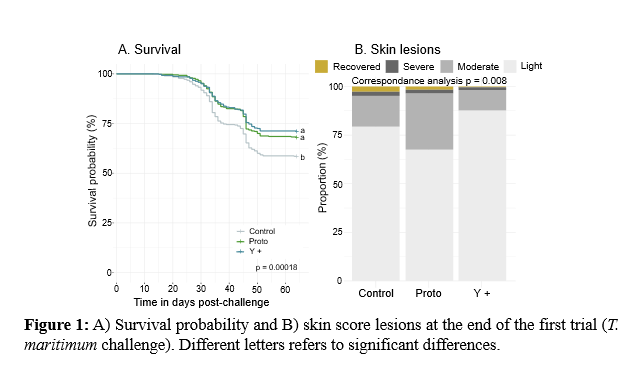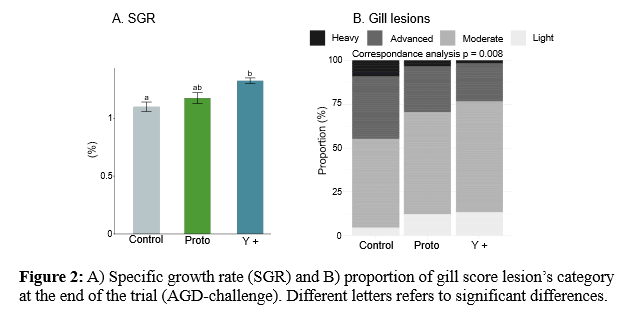ENHANCED RESILIENCE TO MUCOSAL DISEASES IN ATLANTIC SALMON Salmo salar SUPPLEMENTED WITH A NOVEL YEAST-BASED INGREDIENT
Introduction
Farmed Atlantic salmon frequently encounter harmful infectious and non- infectious factors as well as necessary management practices causing serious mucosal health issues across the industry . Functional feeds are commonly used as preventive measures to enhance fish health and well-fare a mong which yeast cell wall (YCW) products are well-established. Two independent trials were conducted to evaluate the potential benefits of in-feed supplementation with specific YCW product on two mucosal-associated diseases ; Tenacibaculosis (T. maritimum challenge) and Am oebic Gill Disease (AGD; N. perurans challenge).
Materials and Methods
B oth trials used a baseline recipe reflecting current commercial practices in the European Atlantic salmon industry. Each trial tested 3 diets in quadruplicate as follow. A non-supplemented diet (Control); and two diet supplemented with two novel YCW products (Proto and Y+ respectively; Lallemand, France) . Feed were fed to apparent satiation over the trial’s duration.
The first trial lasted 15 weeks with f ish exposed to T. maritimum by immersion at week 5. The second trial lasted 10 weeks with fish exposed to a first AGD challenge at week 5 using upstream shedders; followed by freshwater (FW) treatment and a second AGD challenge . In both trial, growth , feed performance and survival were monitored; visual scoring of the gross pathology ( skin lesions and gill score respectively) were performed at interval and mucosal tissue were collected for analysis.
Results
In the first trial ( T. maritimum challenge) and compared to the Control; s upplementation with Y+ resulted in a significant improvement in survival (+22%; Fig 1A ) which was associated with a significant decrease in the proportion of moderate and severe skin lesions (-30% at the end of the trial; Fig 1B). In the second trial (AGD-challenge) ; diet Y+ was associated with improve specific growth rate and feed conversion ratio (+ 20% and -32% compared to the Control, respectively; Fig 2A) over the trial’s duration . Gill scor ing over time documented the propagation of the pathology and the positive impact of the intermediary FW-treatment. At the end of the trial, gill-scoring was significantly improved in dieta ry group Y+ with a marked decrease in the proportion of heavy and advanced scores and, inversely, a higher proportion of fish showing a light AGD-score.
A nalyses of histology, gene expression and mucus qualities will be presented to decipher the beneficial effects of the YCW product on mucosal robustness and disease resilience.
Conclusion
This novel-YCW product as the potential to contribute to the preventive management of gill and skin health in seawater Atlantic salmon. Further trial’s under commercial-like conditions should be performed.

